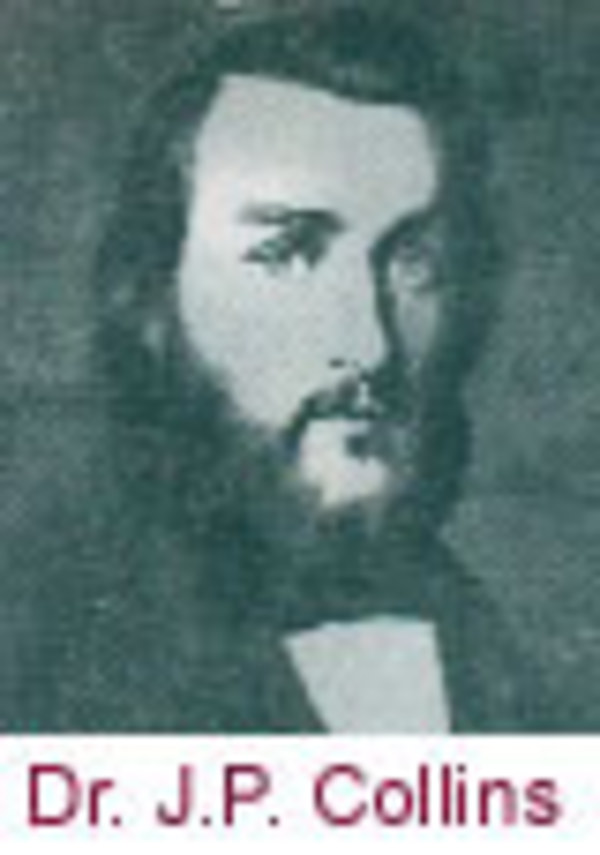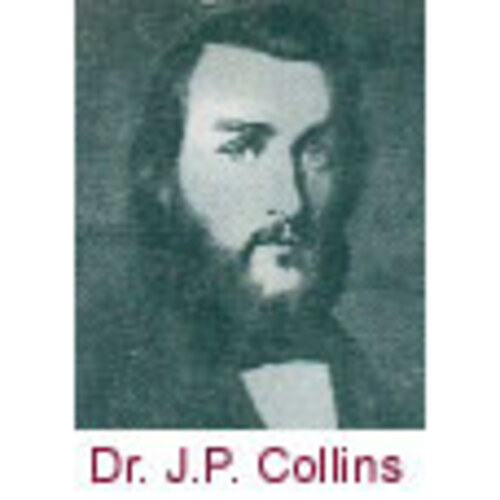
Source: Link
COLLINS, JAMES PATRICK, physician; b. c. 1824 in County Cork (Republic of Ireland), eldest of four children and only son of Patrick Collins and Isabella Hughes; m. 24 Oct. 1846 Mary Quin (Quinn) in Portland (Saint John), N.B., and they had one daughter; d. 2 July 1847 on Partridge Island, N.B.
James Patrick Collins immigrated to Saint John in 1837 with his family. As a youth he apprenticed under Dr George R. Peters, a prominent Saint John physician, who at that time was superintendent of the Lunatic Asylum. Peters fostered his interest in medicine and assisted him in pursuing medical studies, which he undertook in Paris around 1844 and later in London. Collins returned to Saint John in 1846 and that August began medical practice from his family’s residence on Mill Street, York Point.
Collins had been in practice only a few months when in May 1847 a typhus epidemic broke out in North America, the disease having been brought by immigrants fleeing the potato famine in Ireland. Saint John did not escape the pestilence and by early June the hospital sheds at the quarantine establishment on Partridge Island, near the city, were crowded with fever patients and the overflow was being placed in military tents. Almost 2,500 immigrants were in quarantine at this time; many of them were still on board vessels waiting to be landed. The health officer in charge, Dr George J. Harding, could no longer handle his responsibilities alone and sought help. In spite of the risk of contracting the disease, his brother Dr William S. Harding and Dr Collins went to the quarantine station as medical assistants, at a salary of £50 a month.
It was mainly at the insistence of Lewis Burns, who had served briefly as an assemblyman for Saint John, that Collins decided to go to Partridge Island. Burns convinced him that assisting the health officer would enhance his professional reputation and benefit his fledgling medical career. It is quite probable that his brothers-in-law, James and Edmond Quin, both of whom were priests active in charitable work among the immigrants, also encouraged him to go there. Distressed by “the sufferings of his countrymen,” Collins agreed to take up the challenge even against the protestations of his own family, who feared, with reason, for his well-being. Collins played a prominent role in combating the disease but in less than a month fell victim to it. Around 26 June both medical assistants were attacked by typhus and one week later; on 2 July, young Collins was dead. At the urging of his friends, the Saint John Common Council granted special permission for his body to be brought from the island to the Roman Catholic cemetery in Indiantown. Because of the danger from contagion, the corpse was sealed in a lead coffin under the direction of the health officer. The funeral procession on 4 July was most impressive and showed the respect in which Collins was held by the community. Composed of nearly 4,000 persons, it was subsequently said to have been the largest ever seen in Saint John. Several years later Collins’s body was moved to St Peter’s burial ground (near Fort Howe) and in 1949 it was placed in a common grave in St Joseph’s cemetery.
Neither the money Collins’s father earned as a grocer nor that made by Collins during his brief medical career appears to have been enough to support his widow and his posthumous child. In 1847 the New Brunswick legislature justly acknowledged his work at the quarantine station by granting £50 to his estate, and from 1848 to 1855 it gave an additional £205 to his widow, in answer to her petitions for support.
Considered a humane man of much promise in the medical profession, Collins was praised by his contemporaries for his professional talents and his devotion to his native countrymen. Even today his name is revered in Saint John, especially by those of Irish descent. A Celtic cross on Partridge Island and a half-scale replica of it on the mainland commemorate his “devotion and sacrifice” and preserve the memory of more than 2,000 Irish immigrants who died during the typhus epidemic of 1847.
Arch. of the Diocese of Saint John (Saint John, N.B.), Cathedral of the Immaculate Conception (Saint John), reg. of baptisms, 22 Aug. 1847 (mfm. at PANB). City of Saint John, City Clerk’s Office, Common Council, minutes, 1847 (mfm. at PANB). N.B. Museum, Reg. of marriages for the city and county of Saint John, book C: 524 (mfm. at PANB). PAC, MG 9, A10, 5. PANB, RG 3, RS 266, A11b; RG 4, RS24, S61-P282, S62-P260. Partridge Island Research Project (Saint John), “The year of the fever” (uncredited article, Saint John, c. 1904). PRO, CO 188/100–1, 188/108 (mfm. at PAC). St Joseph’s Cemetery (Roman Catholic) (Saint John), Cemetery records (mfm. at PANB). St Mary’s Cemetery (Saint John), Tombstone inscription for Patrick Collins. N.B., House of Assembly, Journal, 1848–55. New-Brunswick Courier, 22–29 Aug., 19 Sept., 31 Oct. 1846; 5, 26 June, 3–10 July, 21 Aug., 4–18 Dec. 1847; 19 Nov. 1853. William Murdoch, Poems and songs (2nd ed., Saint John, 1872). W. K. Reynolds, “The year of the fever,” New Brunswick Magazine (Saint John), 1 (July–December 1898): 202–14. Telegraph-Journal (Saint John), 10–11 Oct. 1927. J. M. Whalen, “‘Allmost as bad as Ireland’: Saint John, 1847,” Archiyaria (Ottawa), no.10 (summer 1980): 85–97.
Cite This Article
James M. Whalen, “COLLINS, JAMES PATRICK,” in Dictionary of Canadian Biography, vol. 7, University of Toronto/Université Laval, 2003–, accessed December 19, 2025, https://www.biographi.ca/en/bio/collins_james_patrick_7E.html.
The citation above shows the format for footnotes and endnotes according to the Chicago manual of style (16th edition). Information to be used in other citation formats:
| Permalink: | https://www.biographi.ca/en/bio/collins_james_patrick_7E.html |
| Author of Article: | James M. Whalen |
| Title of Article: | COLLINS, JAMES PATRICK |
| Publication Name: | Dictionary of Canadian Biography, vol. 7 |
| Publisher: | University of Toronto/Université Laval |
| Year of publication: | 1988 |
| Year of revision: | 1988 |
| Access Date: | December 19, 2025 |



